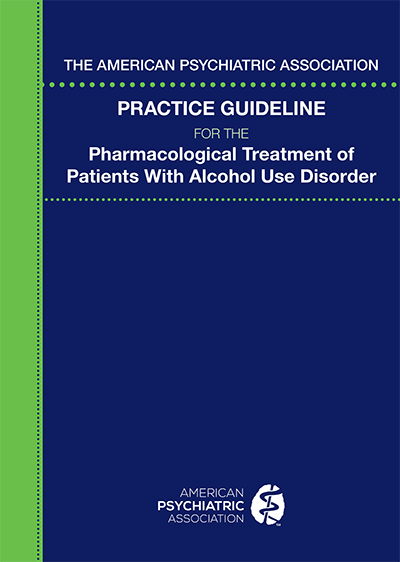APA Releases Practice Guideline for AUD Pharmacotherapy
Abstract
APA’s new guideline for alcohol use disorder provides information on the comparative benefits and risks of acamprosate, disulfiram, gabapentin, naltrexone, and topiramate.
Despite the high prevalence of alcohol use disorder (AUD) in the United States, and the significant financial and public health burden of excess drinking, most people do not receive adequate treatment for this disorder. A recent analysis estimated that only 1 in 10 people diagnosed with AUD receive any treatment, and fewer still receive an evidence-based treatment.

There are likely many reasons for the underuse of treatments for AUD, including a lack of awareness by both patients and providers about their options.
To increase awareness about medications available to treat AUD, APA earlier this month released the Practice Guideline for the Pharmacological Treatment of Patients With Alcohol Use Disorder.
“This new guideline is an important step in bringing effective, evidence-based treatments for alcohol use disorder to many more people and in helping address the public health burden of alcohol use,” APA President Anita Everett, M.D., said in a press release announcing the guideline’s release.
This guideline offers recommendations or suggestions on various aspects of AUD pharmacotherapy. Recommendations reflect confidence that the benefits of the intervention clearly outweigh the harms. Suggestions reflect more uncertainty; the benefits of the intervention are still viewed as outweighing the harms, but the balance between the two may be harder to judge and patient preference is likely to play a greater role in deciding the treatment used.
The specific guidance statements related to the prescribing of the five AUD medications are as follows:
APA recommends that naltrexone or acamprosate be offered to patients with moderate to severe AUD who want to reduce drinking or achieve abstinence, prefer pharmacotherapy or have not responded to nonpharmacological treatments alone, and have no contraindications to the use of these medications.
APA recommends that acamprosate not be used by patients who have severe renal impairment. For individuals with mild to moderate renal impairment, APA recommends that acamprosate not be used as a first-line treatment and, if used, the dose of acamprosate be reduced compared with recommended doses in individuals with normal renal function.
APA recommends that naltrexone not be used by patients who have acute hepatitis or hepatic failure.
APA recommends that naltrexone not be used as a treatment for AUD by individuals who use opioids or who have an anticipated need for opioids.
APA suggests that disulfiram be offered to patients with moderate to severe AUD who want to achieve abstinence and prefer disulfiram or are intolerant to or have not responded to naltrexone and acamprosate. Patients should be informed of the risks of alcohol consumption while taking disulfiram (adverse reactions such as flushing and elevated heart rate occur if alcohol is consumed within 12 to 24 hours of taking disulfiram), and have no contraindications to the use of this medication.
APA suggests that topiramate or gabapentin be offered to patients with moderate to severe AUD who want to reduce drinking or achieve abstinence and prefer topiramate or gabapentin or are intolerant to or have not responded to naltrexone and acamprosate, and have no contraindications to the use of these medications.
In addition, the practice guideline includes recommendations and suggestions related to the psychiatric evaluation of patients with AUD and treatment planning, which are integral first steps toward using pharmacotherapy to treat AUD.
While the guideline statements provide a good synopsis of the current understanding of these medications, Oscar Bukstein, M.D., M.P.H., a member of the Guideline Writing Group, said that it is important for physicians to read other portions of the practice guideline, which include explanations for each recommendation and suggestion.
“The explanations provide important context about when and where certain pharmacotherapies might be appropriate,” said Bukstein, who is a psychiatrist at Boston Children’s Hospital.
Bukstein added patient preference is always important to consider when choosing a pharmacotherapy. He explained that this is why the language reflected some interchangeability among the available options as opposed to ranking the medications in an algorithmic fashion.
Still, as noted in the guideline, naltrexone and acamprosate are the treatments best supported by clinical and research evidence.
“It’s important to keep in mind that these medications are to be used as adjuncts in a comprehensive AUD treatment program, which is why it was important to include statements related to treatment planning,” Bukstein told Psychiatric News. Recommending a particular nonpharmacological approach to be used alongside pharmacotherapy was outside the scope of this practice guideline. ■



